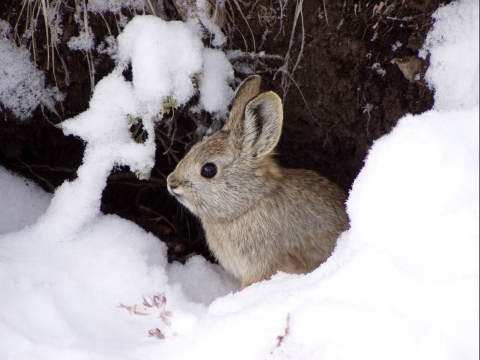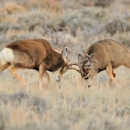Seasons of Wildlife
Spring is a time of excitement as the weather slowly begins to warm across the refuge. During early spring, greater sage grouse congregate on lekking sights, where the males dance and drum their chests in hopes of impressing the females. Migratory waterfowl can be seen at nearby lakes and ponds as they travel to their nesting grounds further north. Swallows feeding on insects over riparian riparian
Definition of riparian habitat or riparian areas.
Learn more about riparian areas and spring wildflowers add color to the landscape.
Summer is a good time to find new mothers chasing after their young. Keep an eye out for pronghorn and deer with fawns and other young wildlife species as you visit the Refuge. Remember, if you see a baby animal, leave it be. Its mother is probably nearby feeding and will return soon. If you are concerned, contact the refuge manager.
Fall is a pleasant time to visit Hart Mountain Refuge as the weather begins to cool off and pronghorn and other species still abound. As the weather cools down, migratory birds begin their migration south, so keep an eye out for waterfowl visiting the refuge on their way to warmer wintering grounds. Fall is a good time to enjoy the dark skies and bright stars while soaking in the Hot Springs or enjoying the quiet at Camp Hart.
Winter is a magical time to visit the refuge. Glistening snow often blankets the ground, so be sure to dress warm. Watch for rough-legged hawks, American kestrels, or eagles flying overhead.
Featured Species
Hart Mountain National Antelope Refuge was established in 1936 to protect the American pronghorn which was in imminent danger of extinction. Together with Sheldon National Wildlife Refuge just a few miles south, the refuge today is important for the conservation of pronghorn, sage-grouse, American pika, California bighorn sheep, redband trout, and hundreds of other wildlife and plants which depend upon sagebrush sagebrush
The western United States’ sagebrush country encompasses over 175 million acres of public and private lands. The sagebrush landscape provides many benefits to our rural economies and communities, and it serves as crucial habitat for a diversity of wildlife, including the iconic greater sage-grouse and over 350 other species.
Learn more about sagebrush habitats found in the high desert of the Great Basin.




